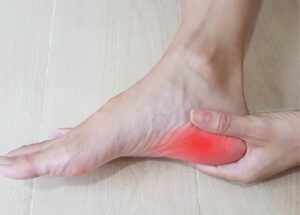By Dr. Isin Mustafa, DPM, MSHS, DABPM, FACPM


First, let’s start with a basic understanding of plantar heel pain also known as plantar fasciitis (PF). Contrary to what a majority of people believe, it is not the bone spur that causes the pain. Rather, it is caused by damage to the plantar fascia. The plantar fascia is a thick-band in the bottom of your foot that provides arch support and shock absorption. Pain associated with PF is typically isolated to the plantar heel (where the plantar fascia inserts on the heel bone) and can occur in the arch region as the plantar fascia travels from the heel to the ball of your foot. Pain can be severe with your first step in the morning or after being seated for an extended period of time. The pain may improve with movement only to return again. If the pain has been present for a short time, it is mainly inflammatory and a strain of the fascia (acute phase). If the pain has been present longer than six months, it is no longer inflammatory but related to degenerative changes. Chronic scar formation is seen with micro-tears of the fascia in this latter stage.
As an active person or athlete there are many factors that you can control to prevent PF. For instance, your training program plays an integral role. You want a program that gradually increases your activity level. This includes both the length and intensity of your program. For example, if you are a long distance runner your weekly mileage should gradually increase. Sudden increases greatly increase your risk of developing PF. In addition, one should consider the environment he or she is training in. Athletes should avoid or limit training on hard surfaces like asphalt or uneven terrain. Hills or other steep inclines should also be gradually incorporated rather than sudden changes in one’s routine. When training, an individual’s exercises should be strategically planned. Activities that are very demanding or have a higher risk of injury (if performed incorrectly) should be performed early in your workout. For example, box jumps have a high risk of Achilles injury and/or plantar fascia injury if done improperly. They are a great example of an exercise that should be performed early in your workout. Footwear is another important factor. A person’s footwear should be the appropriate size and be specific for that sport or activity-taking place. Worn down shoes or insoles must never be used during any activity or sport related activity. My recommendation for athletes, especially long distance runners, is to alternate shoes and/or insoles, as well as, changing your footwear or insoles every 6 months (this can vary depending on your activity level, sport, and how often a user alternates their insoles).
Incorporating recovery into one’s training program is a preventative measure to aid in the prevention of PF. This include various myofascial release techniques like foam-rolling, hyper-volt, and massage. Stretching is another key component. A tight Achilles tendon directly contributes to developing heel pain. Routinely performing Achilles stretching exercises can significantly reduce the chances of developing heel pain and prevent recurrence. Finally, consideration of one’s foot type is essential. For example, someone with flat feet should use some type of orthotics for arch support.
Awareness of potential causes of heel pain and the ability to manage the risks can greatly reduce the likely hood of developing PF and prevent recurrence. If you or someone you know develops heel pain, I highly recommend seeking professional treatment as soon as possible. A professional medical provider will be able to determine the exact cause of the heel pain. Once the etiology of the heel pain is determined, an appropriate treatment plan will be initiated specific to the patient’s lifestyle, foot type, and designed around any sport related activity the patient is engaging in. The sooner professional treatment is given; the sooner the patient can return to their prior activity level.
Isin Mustafa
DPM, MSHS, AACFAS
Isin Mustafa, DPM, is a Podiatrist at Family Foot & Leg Centers in Sarasota, FL. She is a Fellow of the American College of Foot & Ankle Surgeons.
3110 Fruitville Commons Blvd,
Suite 102
Sarasota, FL 34240
(239) 430 – 3668 (FOOT)
www.NaplesPodiatrist.com
 Southwest Florida's Health and Wellness Magazine Health and Wellness Articles
Southwest Florida's Health and Wellness Magazine Health and Wellness Articles

